Coalescent Lights
26-30 March, 2024
at Christie's Hong Kong
22/F Alexandra House, 18 Chater Rd, Central, Hong Kong
On view at Christie’s Hong Kong from March 26 – 30 March 2024, Coalescent Lights curated by Kami Gahiga celebrates distinguished luminaries who share a history of having showcased at 1-54 Contemporary African Art Fair. The exhibition weaves together a rich tapestry of aesthetic philosophies and approaches, offering a unique opportunity to glimpse into developments within contemporary African art.
Coalescent Lights is the third iteration of the 1-54 Presents exhibition series, its very first in Asia, and draws on conceptual threads across multiple artistic generations, highlighting 1-54’s unwavering commitment to expanding the discourse on contemporary African art. For the past twelve years, the fair has greatly contributed to the institutional and market recognition of African artists. The show spotlights a curated selection of artworks by artists who have enriched the canon and left a significant mark at 1-54, spanning a vast array of mediums, including painting, photography, sculptural installation and textile pieces.
It unfolds in five parts: tradition, spirituality and ancient knowledge interwoven with personal and cultural memories; the relationship to intimacy and the body; environmental and material boundaries; translocation and the ephemeral, culminating with concerns over representation and visibility across mediums.
With Coalescent Lights, 1-54 presents at Christie’s in Hong Kong a curated presentation of African artists that illuminates the vibrant spectrum of voices, perspectives and artistic approaches within contemporary African art.
Inspired by French-Cameroonian curator Simon Njami’s call for a nuanced understanding of this field, the exhibition celebrates its transdisciplinary nature. Njami’s vision of the contemporary as “multi-dimensional and constantly in motion, refusing confinement and categorization” underscores the exhibition’s dedication to spotlighting the vast diversity of talents within contemporary African art [1].
Exhibited artists:
Omar Ba, Ouattara Watts, Ibrahim El-Salahi, Barthélémy Toguo, Wura Natasha-Ogunji,
Ibrahim Mahama, Virginia Chihota, Tariku Shiferaw, Tesfaye Urgessa, Joël Andrianomearisoa,
Tadesse Mesfin, Youssef Nabil, Abdoulaye Konaté, Sanaa Gateja, Dalila Dalléas Bouzar, Aboudia, Zanele Muholi,
Seydou Keïta, Baya, Cheikh Ndiaye, Edson Chagas, Prince Gyasi, Samuel Nnorom, Cornelius Annor, Moffat Takadiwa, Serge Attukwei Clottey, Joana Choumali.
Artwork Highlights
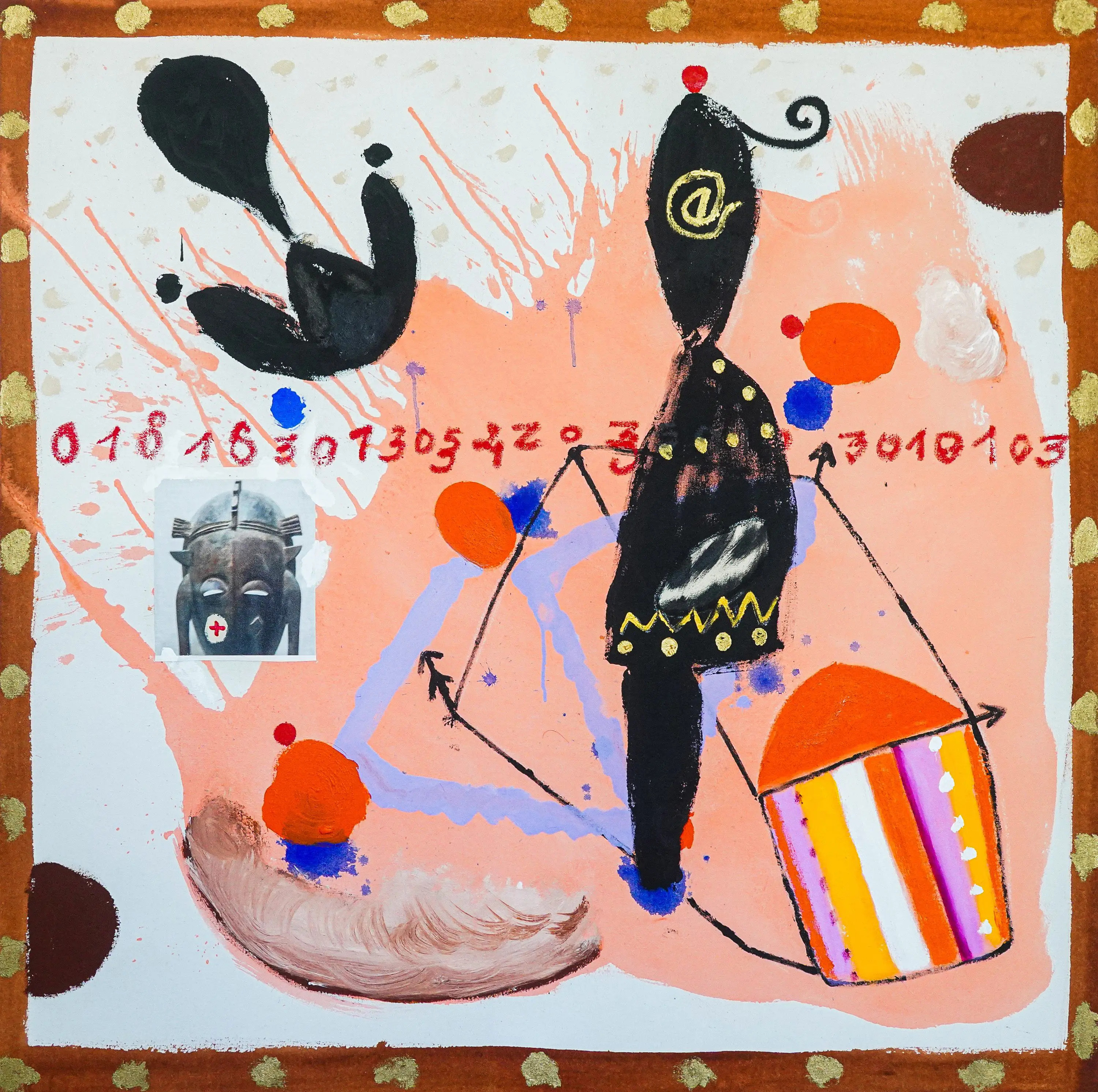
Ouattara Watts
Born in 1957 in Korhogo, Ivory Coast
Lives and works in New York, USA
Ivorian-American painter Ouattara Watts’ work evokes imaginary worlds and mystical visions, delving into African cosmogony and alchemy to contemplate the metaphysical connections between beings. Conjuring both contemporary and ancestral realms and merging objets trouvés, photography and other media. Watts’ work invokes the artist’s multinational identity and invites diverse social and historical readings. Watts grew up in a family with a syncretic approach to spiritualism, integrating elements of Catholicism, Islam, Sufi mysticism and African religions. The artist grew up in Ivory Coast and relocated to Paris in 1977 to pursue his studies at the École Nationale Supérieure des Beaux-Arts before moving to New York in 1988 after meeting Jean-Michel Basquiat, who encouraged him to move to America. The lyrical abstraction of Kazimir Malevich and the meditative quality of Mark Rothko’s paintings, which Watts encountered in Paris and New York, influenced the artist’s deep exploration into a spiritual language transcending religious and cultural boundaries. Like the title of his painting Intercessor #5 (2022) Ouattara Watts refers to the symbols within his artwork that serve as mediators and connectors between different realms and cultures. Ouattara Watts has been exhibited at the Whitney Biennial, the National Museum of African Art, the Smithsonian Institute, the Venice Biennale, and MoMA.
“My vision is not based on any country or continent; it’s beyond geography or what can be seen on a map. Even though my pictorial elements can be located, so they can be better understood, this is about something much wider. My paintings refer to the Cosmos.” – OUATTARA WATTS QUOTED IN: CHRIS SPRING, ANGAZA AFRIKA: AFRICAN ART NOW, LONDON, 2008, P. 324
Barthélémy Toguo
Born in 1967 in Mbalmayo, Cameroon
Lives and works between Bandjou, Cameroon and Paris, France
Barthélémy Toguo’s artistic practice spans various mediums including painting, drawing, sculpture, photography, performance, and installation. Toguo studied at the École Nationale Supérieure des Beaux Arts in Abidjan, Ivory Coast between 1989-1993, followed by the École Supérieure d’Arts in Grenoble, France, and the Kunstakademie in Düsseldorf, Germany where some of his notable encounters included Tony Cragg, Jannis Kounellis and Konrad Klapheck. Toguo explores enduring themes and breathes life into a spiritual dimension that blurs the boundaries between the natural and human worlds. Using dynamic brushwork with watercolour blue ink, Toguo depicts poetic and hopeful gestures that connect nature with the human body. In pieces like Human Spring 11 (2023) where hands and a fish coexist within the composition, Toguo draws inspiration from the aquatic world, celebrating the virtues of water evoking a sense of dynamism and fluidity. Through his works, Toguo seeks to address ecological and societal concerns, emphasizing the interconnectedness between humans and the environment
“I love the shape of fish and invent aquatic environments. With the sea in mind, I often draw the blue dotted lines in my work. I imagine rain and oceans transforming a scene or landscape into a marine universe.
I marvel at the fluidity of water, which represents a gentle, non-violent world; its colour is undeniably beautiful. Water is an ‘’invaluable and vital element that invites us to dream and gives us life, ‘says the artist, concerned that this resource, which should be a right for everyone, is cruelly lacking in several parts of the planet, endangering the living world’’. – Barthélémy Toguo Interview with the artist by Androula Michael, Nantes, 13 June 2023.
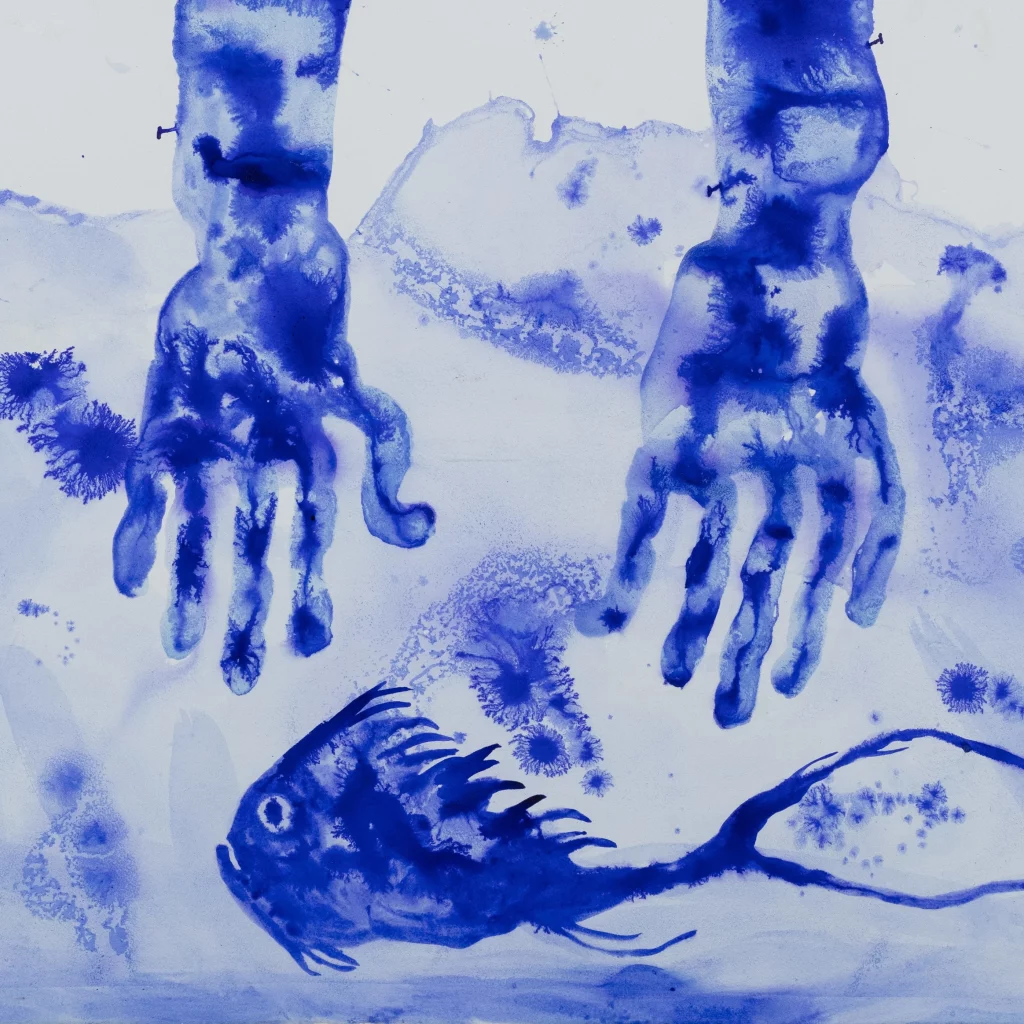
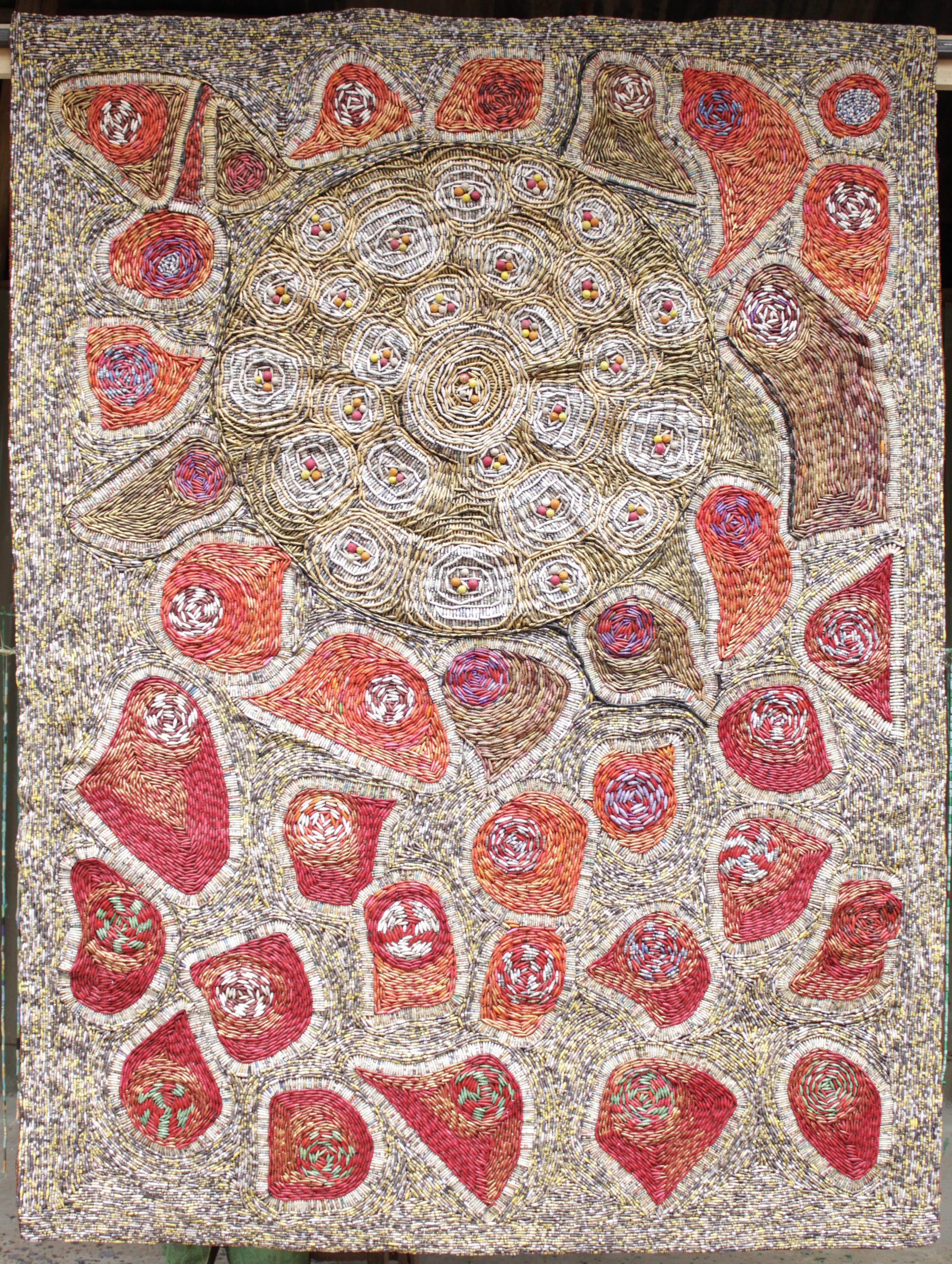
Sanaa Gateja
Born 1950 in Kisoro, Uganda
Lives in Kampala, Uganda
He is a multimedia artist who is best known for his soft sculptures. They are composed of hundreds of “beads” made of recycled paper that are stitched one by one onto bark cloth — a Ugandan traditional canvas that is made from the bark of a Ficus tree — and created colourful abstract or semi-abstract motifs. Inspired by colonial taxonomy, rural values, or by contemporary philosophies of nature, he seeks to examine the history and spiritual heritage of East Africa and investigate the impact of development and climate change to Ugandan’s rich ecosystems, and foster community cohesion.
Early in his life Uganda’s civil war led Sanaa Gateja to a long span of diasporic life, in Kenya, in Italy and in the UK where he studied respectively at the International University and at the Camden University of the Arts, returning to Kampala where he lives now only in the late 1990s.
Zanele Muholi
Born 1972 in Umlazi, Durban, South Africa
Lives and works between Durban and Cape Town, South Africa
Zanele Muholi is a visual activist who documents and archives the lives and struggles of LGBTQI+ communities, evokes the fate of black South African women workers, violence and questions of identity, through portraits, photographs, calligraphy, installations or more recently paintings and sculptures.
Muholi’s self-proclaimed mission is to ‘rewrite a black queer and trans visual history of South Africa for the world to know of our resistance and existence at the height of hate crimes in South Africa and beyond’. Creating a powerful, daring aesthetic, with an incredible evocative force, Sir Muholi freed themself from codes and rules to give us new canons, new models.
‘I have photographed so many people, I have captured so many videos and have documented painful experiences of other people without dealing with my own pain, I needed to remember me’. Zanele Muholi
– “In My World Every Human is Beautiful” | Tate.
Muholi studied Advanced Photography at the Market Photo Workshop in Newtown, Johannesburg, and in 2009 completed an MFA: Documentary Media at Ryerson University, Toronto. In 2013 they became an Honorary Professor at the University of the Arts/Hochschule für Künste Bremen and have since received numerous accolades,awards and titles.
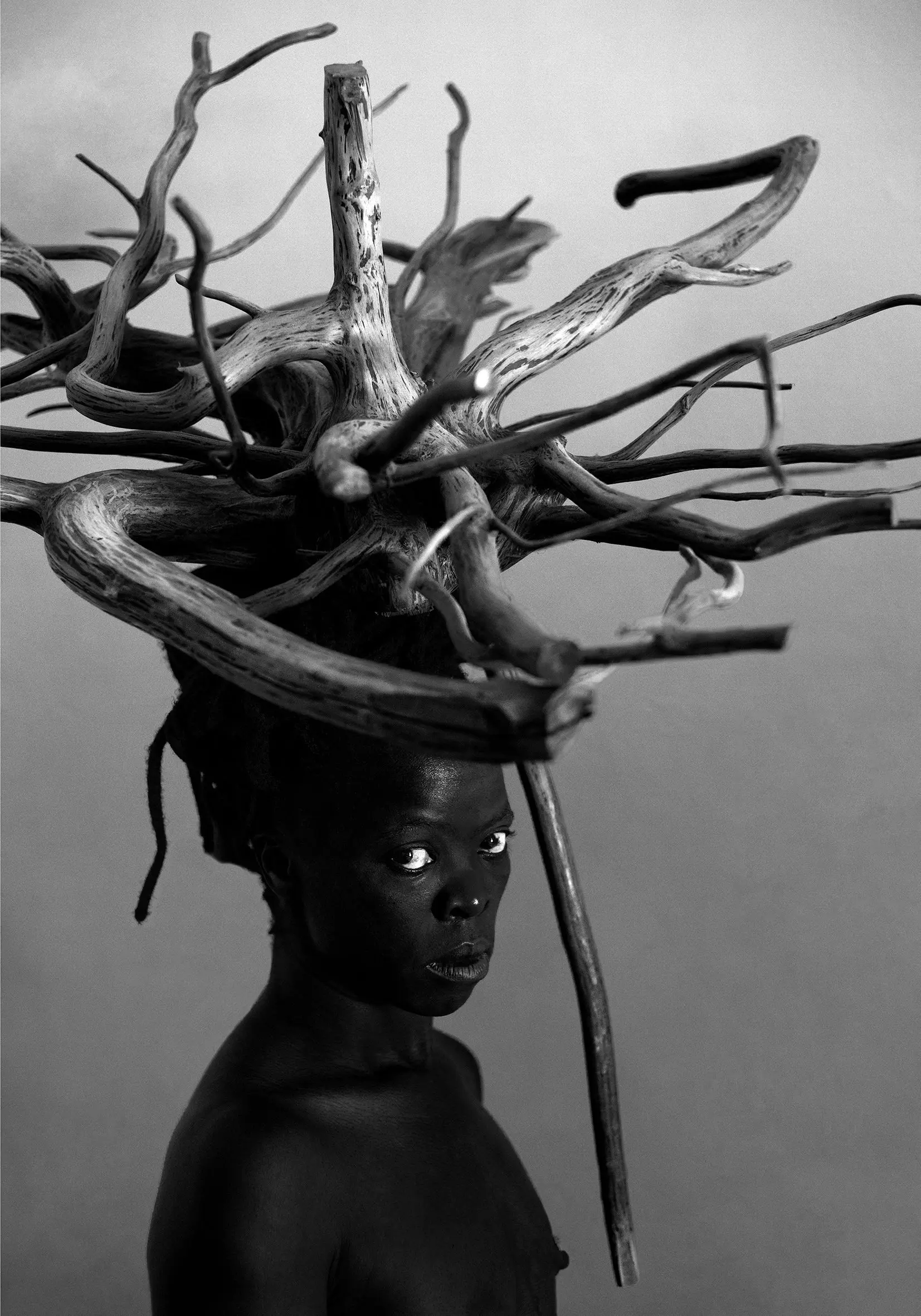
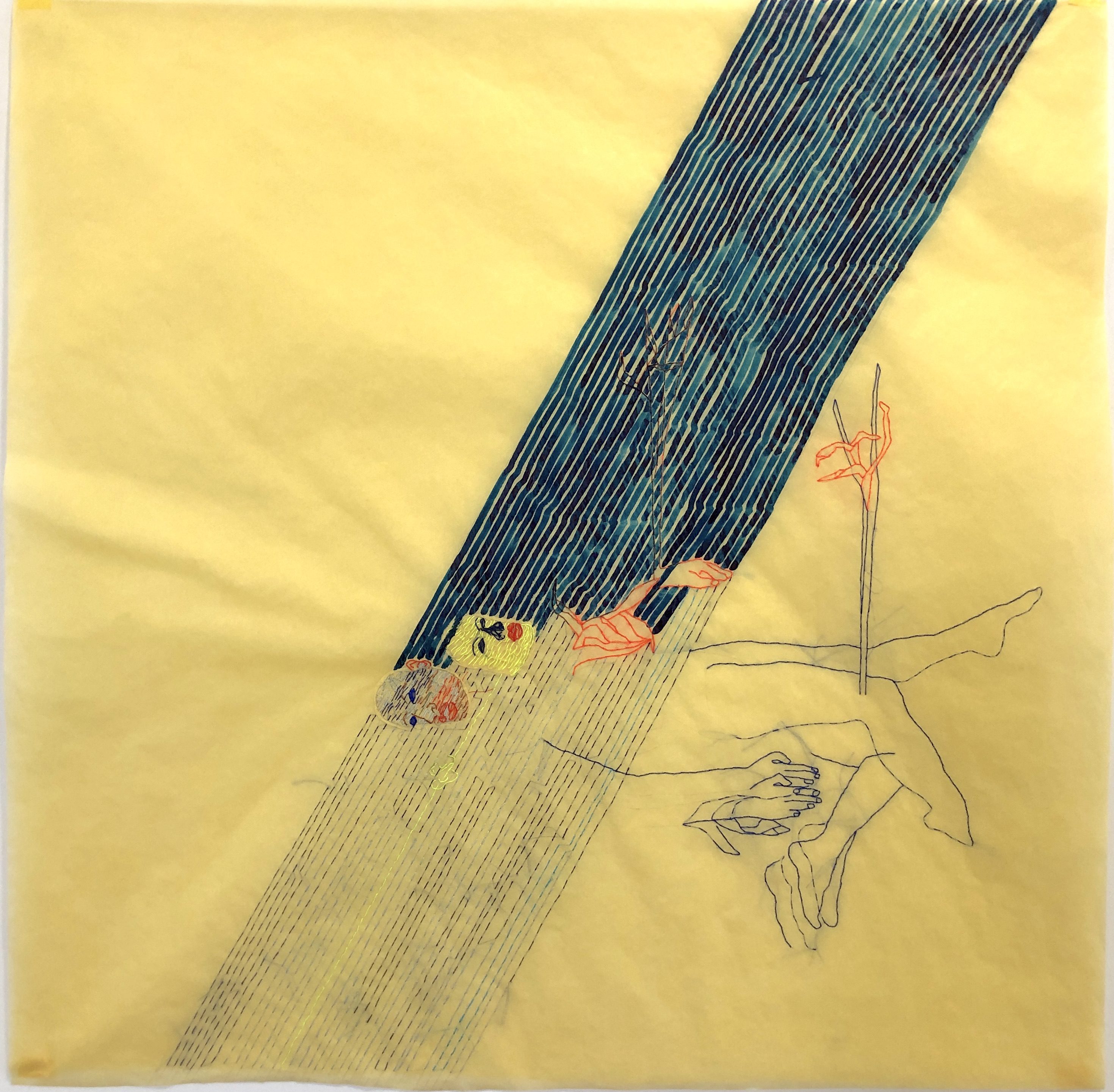
Wura-Natasha Ogunji
Born 1970 in St. Louis, Missouri, USA
Lives and works in Lagos, Nigeria
Wura Natasha-Ogunji is a multidisciplinary Nigerian-American artist whose practice encompasses drawings, video, and performance. Her displayed works in the exhibition exhibit a quiet and deeply meditative quality, comprising hand-sewn figures heightened with ink and graphite on architectural tracing paper. The artist delicately hand-stitches and draws figures on both sides of the paper, adding softness as well as depth of emotion to her work. Ogunji holds a Bachelor’s degree in Anthropology from Stanford University and an MFA from San Jose State University in Photography. Speaking about her practice, Ogunji explains how it allows her to “explore the outer limits of my imagination in a manner that is linked to the imaginations and experiences of others existing in the world [1].” Her most recent creative investigations focus on the presence of women in public space in Lagos, Nigeria. In many of her drawings, such as Let the River Take Us (2022), Ogunji explores water as architecture and employs stitched lines to depict the flowing movement of a river while also conveying her experiences as a woman living in Lagos.
[1] In Conversation with Wura-Natasha Ogunji, Theresa Sigmund. Contemporary & (2017)
‘’The paper itself serves as a veil or curtain, maybe even a fragile wall between what is and what is possible. With the stitches seen from reverse, the knots and cut threads reveal something critical and necessary, the beauty of beauty’s underside.” Wura-Natasha Ogunji
Tesfaye Urgessa
Born 1983 in Addis Ababa, Ethiopia
Lives and works in Addis Ababa, Ethiopia
Tesfaye Urgessa presents poignant compositions informed by classical art and Ethiopian iconography that engage with contemporary and socio-political issues. Urgessa first started his artistic studies at the Alle School of Fine Arts in Addis Ababa in 2002 where he studied composition theories and took courses in sculpture, painting, and non-figurative painting. His education was rigorous, practical, and academic with the stylistic heritage of both traditional Ethiopian religious art and communist characteristics. After graduation, Urgessa moved to Germany in 2009 with a scholarship to continue his art studies at the Staatlichen Akademie der Bildende Kunst in Stuttgart where principles of open mindedness and experimentation were at the core of his education.
In his last year at the Academy, Urgessa was awarded the Akademie’s Fine Arts Award. This dual training in both Ethiopia and Germany enthuses Urgesssa’s unique and highly skilled visual language.
His painting included in Coalescent Lights, forms part of the series No Country for Young Men, Urgessa’s extensive exodus series which wrestles with themes of migration and seeks to expose the challenging circumstances of refugees in their journey to reach new beginnings. As the artist watched the news of the myriad of migrants crossing the Mediterranean Sea towards European shores in harrowing conditions, he became consumed with the images of flows of people arriving barefoot and described hearing footsteps walking relentlessly for days “like marching bands or soldiers’’. Haunted by their strenuous journey, he began painting his series from the bottom, beginning with the feet which so predominantly feature in his displayed painting. Tesfaye Urgessa will represent Ethiopia for the country’s first-ever national pavilion at this year’s 60th Venice Biennale.
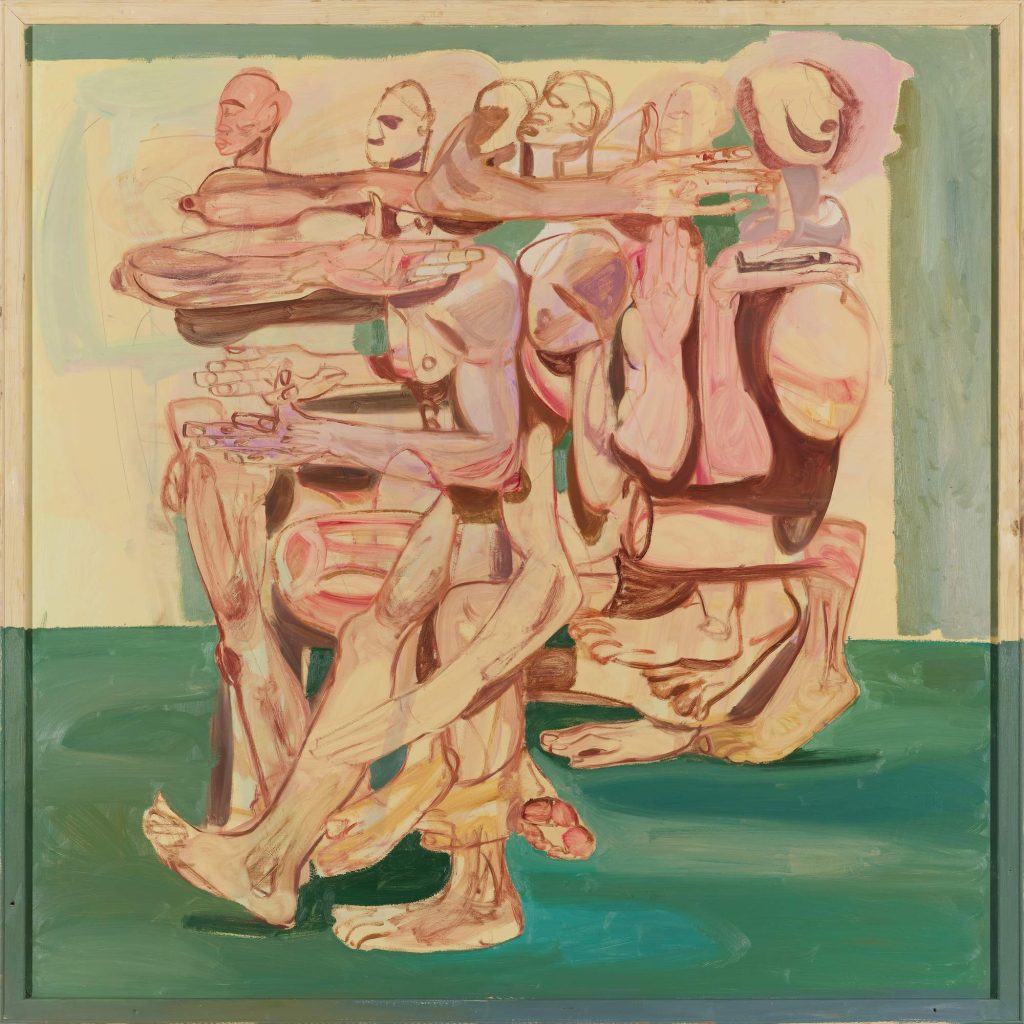
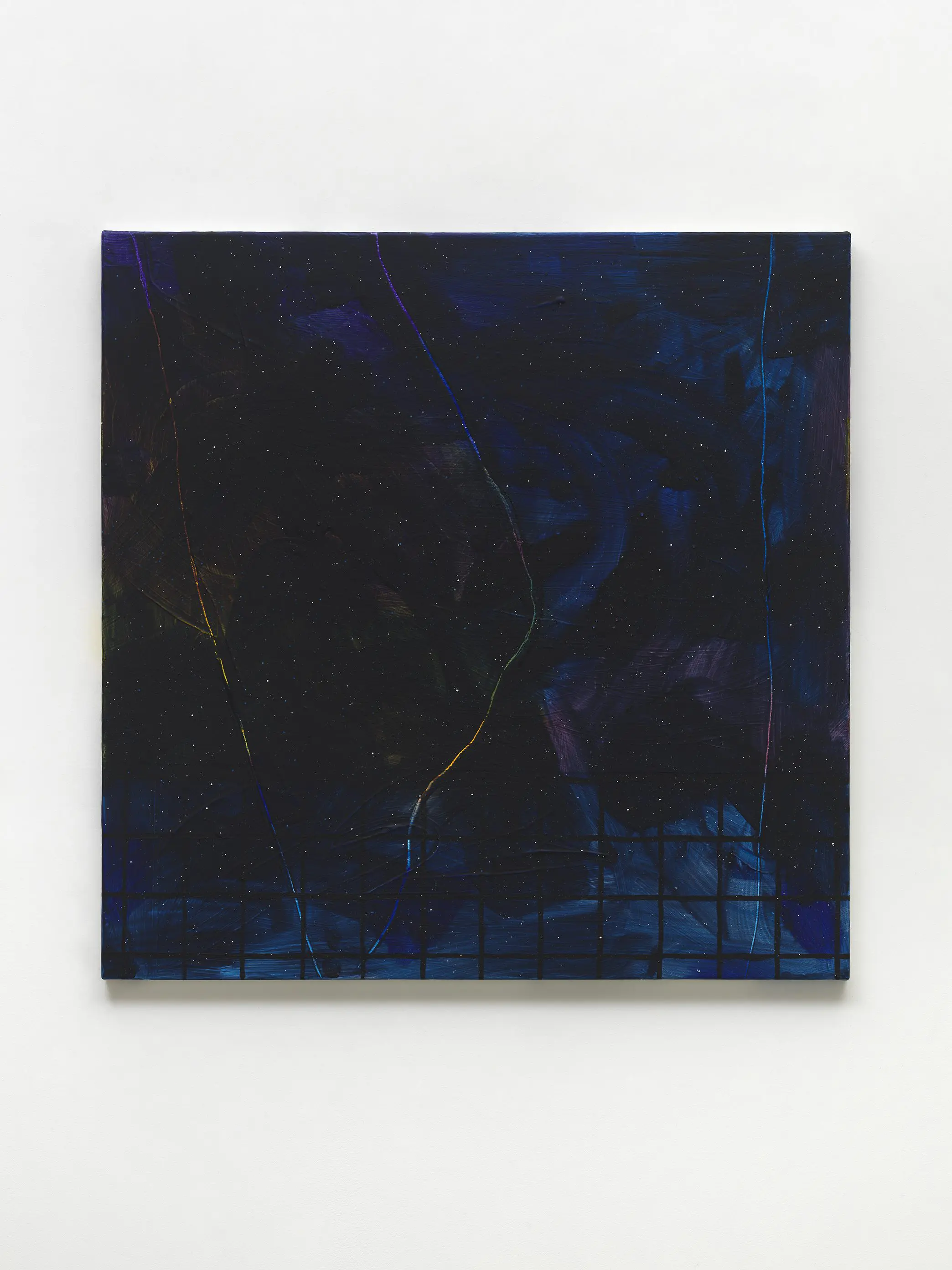
Tariku Shiferaw
Born in 1983 in Addis Ababa, Ethiopia
Lives and works in New York, USA
Tariku Shiferaw’s geometric abstractions are embedded with mark-making that delves into both the physical and metaphysical spaces of painting and societal structures.
Shiferaw pursued a Bachelor of Fine Arts (BFA) at the University of Southern California (USC) in 2007 and later attained his MFA at Parsons The New School for Design in 2015.
Bantu Migration, his painting exhibited in Coalescent Lights, was executed this year as part of a new series titled, “Mata Semay” (Amharic for night skies), which proposes a new mythology that ponders how the night sky would seem if diasporic cultural contributions were considered in the global consciousness. “Mata Semay” depicts this imagined night sky, combining painting, sound and sculpture, fusing abstraction that re-engages ancient and contemporary African diasporic knowledge with noise and image-making practices. It investigates the night sky as a canvas upon which different civilizations have inscribed their visions of the world, the influence of mythologies on the order of social codes and what occurs when boundaries become porous. In Shiferaw’s abstract composition, Bantu Migration (2024) translucent lines serve as visual representations of border demarcations, symbolizing boundaries that transcend colonial impositions. Against the backdrop of the expansive night sky, these lines evoke a sense of liberation and freedom. The artwork embodies the concept of the Bantu Migration, illustrating the movement of Sub-Saharan Africa’s largest ethnic group across vast territories.
Ibrahim Mahama
Born in 1987 in Tamale, Ghana
Lives and Works in Tamale, Ghana
Ibrahim Mahama is a Ghanaian multidisciplinary artist most renowned for his monumental draperies made from found objects and materials which carry traces of physical labor.
Mahama earned his Bachelor of Fine Arts in Painting in 2010 and a Master of Fine Arts in Painting and Sculpture in 2013 from Kwame Nkrumah University of Science and Technology (KNUST). His artistic vision draws from a rich tapestry of influences, notably shaped by the revolutionary teachings of artist and professor Karî’kachä Seid’ou, whose mentorship at (KNUST) expanded Mahama’s conception of art to encompass one’s own background and immediate environment. Another key influence in Mahama’s work is Robert Rauschenberg’s hybrid works which combined aspects of painting and sculpture by incorporating found materials onto the canvas, expanding the possibilities of artistic expression. Mahama’s oeuvre delves into the economic history and process-based qualities inherent to his chosen medium. The jute sacks, sourced from Southeast Asia and imported by the Ghana Cocoa Board for bean transportation, bear weathered patinas and tactile imperfections that narrate the stories of their journey. Mahama’s intricate woven compositions serve as archival documents, illuminating the contributions of the “invisible collaborators” involved in their creation and transportation. These works symbolize the movement of goods and people across the globe, underscoring themes of labor, resource, and historical narratives.
Mahama’s artistic endeavors have garnered international acclaim, earning him the prestigious Prince Claus Award in 2020. In 2019, he established The Savannah Centre for Contemporary Art (SCCA) in Tamale, Ghana, serving as a multifaceted platform for artistic expression, research, and cultural preservation.
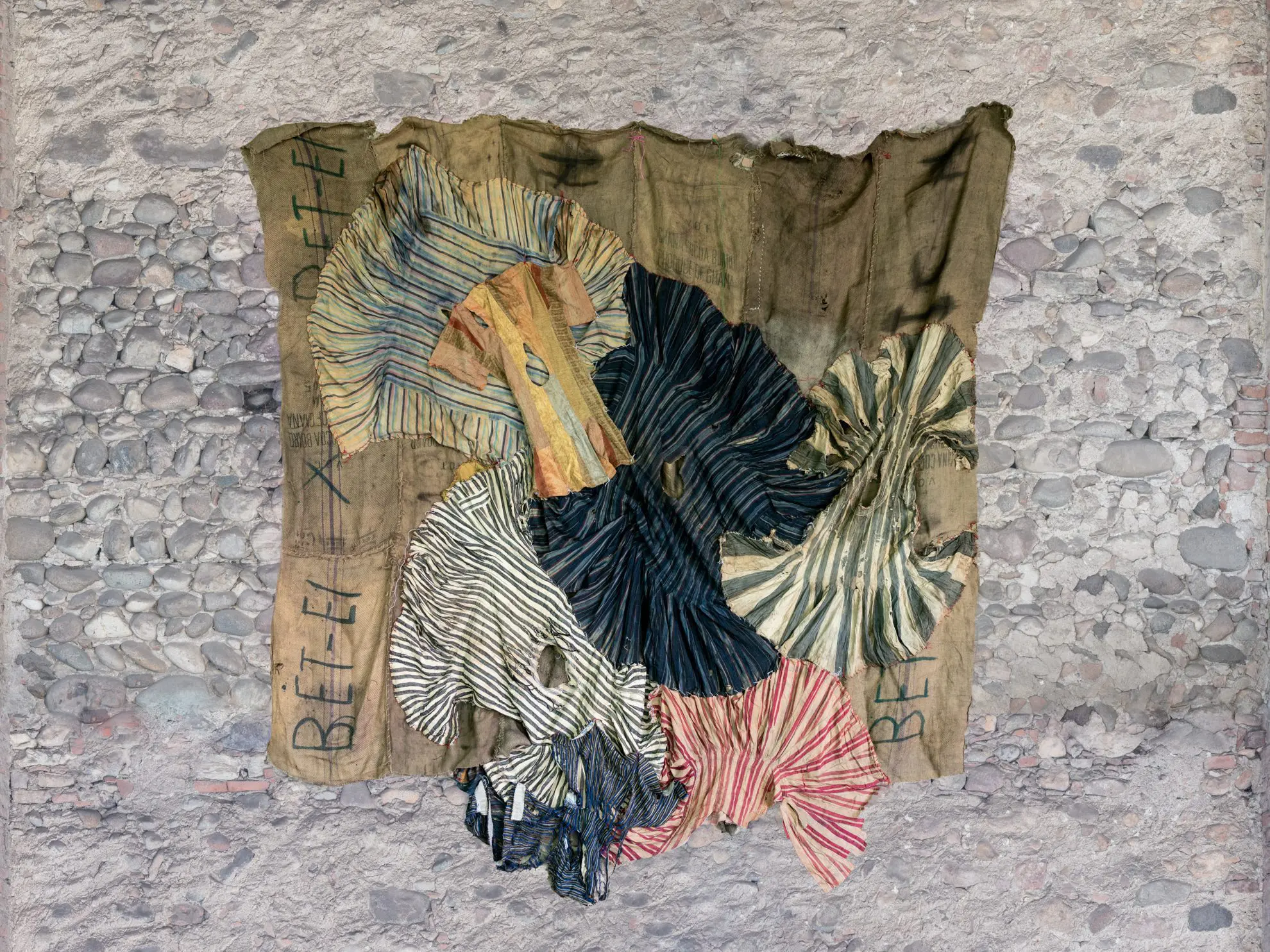
Sales
For sales enquiries please contact: [email protected]
- Opening dates & hours
10 AM – 6 PM
- Location
22/F Alexandra House,
18 Chater Rd, Central, Hong Kong